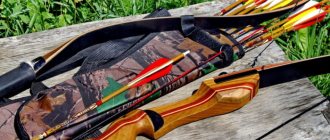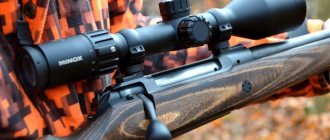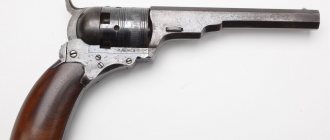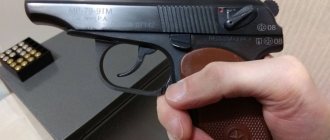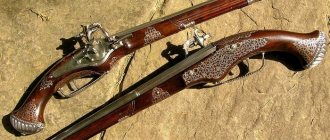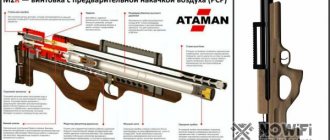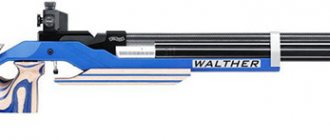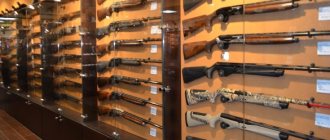In ancient times, bows were the main weapon of many armies around the world, mainly the Greeks and Romans. They were popular for a short period of time. With the advent of firearms, they were decommissioned. But interest in them has revived among people relatively recently. People began to become interested in them en masse in the late 1990s and early 2000s, when films about hobbits appeared on television screens. Also, after the release of the book about Robin Hood, many also became interested in such ancient weapons.
In this article we will analyze the main types of these weapons, tell you the advantages and disadvantages, describe the characteristics, and also make a rating of the best sports and hunting bows.
Types of bows
The design, which was called the bow, developed and improved over several millennia. Thanks to this progress and constant development, 3 types of bows were formed.
Traditional
Peoples used it until they invented different types of firearms. Simply put, these are bows of the autochthonous peoples of Asia and Europe (that is, primitive people).
They are made from leather and wood. Each bow is special and has its own unique characteristics, which is why it is not mass produced. Entire years of training will be needed to become a master and thoroughly master this weapon.
Classic
Another name is “Olympic” because they are used primarily for sports competitions. Most bows of this type have a recurve shape. By bending the elastic branches, the energy for the shot is accumulated.
The classic design allows you to accumulate 2 times more energy than the traditional one. The Huns were the first to use recurve bows. After this equipment began to be equipped with additional attributes that increased shooting accuracy to maximum values, they began to be used for sports competitions. Additional elements included:
- vibration dampers;
- shelves for arrows;
- balancers;
- sights.
A shelf for holding arrows has become an essential attribute of classic bows. This device prevents the arrow from hitting the handle when it leaves the string. Thus, it was possible to replace natural feathers with hard stabilizers, which allow you to increase shooting accuracy to the maximum, while applying little effort.
The results will not be immediately noticeable, since it is very difficult to tighten the bowstring. After hard training, your results will gradually begin to improve.
Block
They first appeared in 1969 in the USA. The design increases the forces applied to the running end. This happens thanks to special blocks called pulley blocks. The more of them installed, the stronger the shot will be. The energy of the throw is accumulated mainly in the cable system, and not due to the force made. A special feature of these bows is the “wall” effect – force release when the maximum draw point is reached. It reaches 80 percent. For example, if a bow has a draw weight of 27 kg, then holding the string will require a force of 4 kg.
How to choose your first compound bow?
Archery quickly became a popular sport in Russia; all sorts of tournaments, 3D competitions and championships that are held everywhere in many cities of our country are proof of this. But it is not only sport that attracts people to the ranks of Archery; many hunters realize their potential with great interest and pleasure, obtaining the desired trophies with a bow and arrow, and specially equipped hunting enclosures fully make bow hunting legal on the territory of the Russian Federation. In In connection with the above, it is not difficult to understand that the number of fans of archery is becoming more and more every day. And one of the main questions for beginners is: “Which compound bow is the best?” And the most correct and at the same time simple answer to this question: “The best one is the one from which you shoot best”!
One of the most difficult parts of choosing your first bow is immersing a beginner in an abundance of information full of preconceived ideas about specific brands, their systems and characteristics, based solely on someone else's opinion; or, as in most cases, on the marketing imposition of professional traders. All this, of course, has the right to life, but, nevertheless, first of all, you must understand the simple truth: “Every sandpiper praises his swamp.”
Now about the main thing - choosing the first bow.
Choosing a compound bow is a very personal matter. And here many factors play a role, ranging from your financial capabilities, ending with your anthropometric data and the specific tasks that you set for yourself and your bow. In this regard, you need to know exactly what characteristics of a bow will be your helpers and allies on the path to mastering archery, and therefore, before making a final decision, you need to understand some of the nuances that ardent marketers are unlikely to emphasize. So, let's begin!
BRACE HEIGHT - Base Luka!
The base of the bow is the first thing you should pay attention to. The base is the distance from the bow handle to the bow string when the bow is at rest. Bows come in short, medium and long base.
The theory regarding bow base length was that a bow with a short base would be more difficult to shoot more accurately. And this is true, this is due to the fact that on bows with a short base, for example 6 inches, the arrow is on the string during a shot much longer than on a bow with a longer base, and therefore, the arrow has more time to hit with shooter errors during the shot. Twisting the handle, jerking the release, all this will inevitably affect the arrow coming off the string and, as a result, an inaccurate hit.
And bows with a longer base are considered just the opposite, as more comfortable and accurate. Because the arrow leaves the string faster and does not have time to absorb the shooter's shooting errors, the result is a more accurate hit. In this regard, in order to make it easier and more comfortable for you to master archery techniques, be sure to focus on a bow with a base of at least 7 inches.
AXLE-TO-AXLE Bow Length.
The question will undoubtedly arise: should you choose a long or short bow?
Short bows very quickly gained recognition among shooters, and they began to enjoy especially great popularity and demand among hunters. And this trend has dominated the market for just a few years, and has been well received by both users and compound bow manufacturers. After all, short bows are obviously lighter, more maneuverable, more convenient for all kinds of tristands and ambushes, and they are also preferable in conditions of approach hunting or when catching an animal.
I would also like to say that most of the modern short bows that we tested in the field worked very well. But nonetheless! One thing to keep in mind is that shorter bows tend to react when the handle is twisted. When stretching and holding the bow while aiming, the bow handle may deviate slightly from the axis of the shot, which inevitably affects the accuracy of the shot. As for bows with a longer axel, they are undeniably and unambiguously more accurate, and this is especially noticeable at longer distances. However, if you do not plan to shoot further than 30 meters, then a short-axle bow will easily show excellent accuracy.
RATING FPS - bow speed.
Everyone goes through this! A beginner behaves something like this: “I want the fastest bow in the world, the faster the better! Want Want want ! And it doesn’t matter how much money this bow will cost me.”
And only after time, with experience, practice and understanding of the whole process, speed begins to fade into the background, or even into the background. Flashy advertising slogans 310fps, 320fps were really relevant 15 years ago. And now we live in a world where a budget bow can easily produce 330fps, and this surprises no one.
But, let's return to the question of choosing the first compound bow in terms of speed characteristics. And here we don’t have a definite answer, since maybe a fast bow with an aggressive block system is suitable for you, but maybe not. You just need to ask yourself the question: “In what conditions will I use this or that bow?” Target shooters are looking for a smooth, comfortable stretch cycle where every stretch is carefully controlled down to the smallest detail. 3D shooters, for a number of reasons, on the contrary, tend to favor faster and more aggressive bows, but in both cases the choice still remains purely individual. As for hunters, here too there are a number of nuances that it is advisable to consider before purchasing a bow. One example: if on warm summer days or in the gym, you practice with your bow and feel all its rigidity and aggressiveness, imagine what it will look like while hunting, sitting on the stand, considering that you have been sitting still for a long time, and when Naturally, we were slightly frozen. Even if you, which we doubt, manage to stretch your aggressive bow, it will definitely not be possible to do it quietly and unnoticed by the object of the hunt. Just remember, it’s not for nothing that they say that the best is the enemy of the good, and therefore, aggressiveness and speed can sometimes play a very cruel joke on you.
PHYSICAL WEIGHT - Bow weight
In addition to bows getting shorter and shorter, they are also getting lighter and lighter. And in the era of carbon bows, the weight has become incredibly light indeed. The same applies to accessories for bows; the manufacturer tries to make them as light as possible. And this is undoubtedly great, but only in those cases when you are going on a hunt, where you have to march over rough terrain, or in the mountains, in search of mountain goats, or in the taiga, chasing an elk.
So when considering the weight of your new bow, think about how far you will have to travel with it to achieve your desired trophy. In all other cases, we still advise you to take a closer look at standard-weight bows, and it is better to give preference to heavier bows, since heavy bows with a good heavy weight undoubtedly shoot much more accurately than light ones. And this fact is directly related to residual vibrations during a shot; light bows react very strongly to vibrations, which, in turn, affects the loss of accuracy.
DRAW LENGTHS-Stretching the Bow
It is very important for a beginner to know as accurately as possible the length of his drawbar, which will subsequently be set on the new bow. The thing is that if you make a mistake and set the drawbar too long, this will inevitably create problems when shooting and, as a fact, will have a detrimental effect on accuracy, you simply will not be able to find a suitable point of attachment, and shooting while pulling will become completely impossible. Therefore, pay special attention when choosing a stretch that is suitable for you based on your anthropometric data. (You can read how to determine the draw length of a bow here)
Comfort comes first.
In conclusion, I would like to say: Comfort when shooting is the key to success.
Your muscles and your bow must work in harmony, and only in this case you will be able to master the shooting technique in the shortest possible time and experience the beauty of an accurate shot! So, if you really want to find the best bow for shooting, you need to decide on the goals and objectives that you want to achieve while shooting with this bow, and then you will definitely be able to choose the one that will accurately hit your targets best. ! Next > Still have questions?
Efficiency
Classic bows do not have much penetrating power. During the descent of the bowstring, they give all the force to the arrow. Such devices fly at a speed of no more than 50 meters per second. Although they do not have great penetrating power, thanks to this mechanism, the rate of fire can be increased.
Block ones accelerate slowly, but their maximum speed reaches 90 meters per second. They are often classified as hunting weapons because they have a low rate of fire, but the accuracy and accuracy of hits is virtually identical to that of firearms.
The average price is approximately 11 thousand rubles.
Which bow is best to buy for shooting?
When choosing such a weapon, you need to consider its flexibility, length and power. The recommended parameters are determined by the height and build of the future owner, as well as the shooting style. For comfortable use of the bow, it is important that the maximum tension of the bowstring does not cause excessive difficulties.
The flexibility and power of a weapon largely depend on the length of the shooter's shoulders. Some models provide owners with the ability to adjust the size using special blocks or telescopic mechanisms. The most powerful bows have a length of over 1.77 m and a bowstring stroke of about 85 cm.
You should pay attention to the maximum speed of the arrow. This indicator is influenced by its design features and weight. But to a greater extent, everything is decided by the actual tension of the bow. The most lethal models are those that provide an arrow flight speed of over 80 meters per second.
It is important to consider the ease of use of the bow. For comfortable use, it should be light and not slip out of your hands. The folding design makes it easy to store and transport. Additional accessories are welcome.
Since 2022, hunting with a bow is allowed. To do this, you will need a hunting license, permission to store and carry, as well as registration with the Russian Guard within 14 days after purchasing the bow.
Recommendations: 12 Best Crossbows
12 best body armor
14 Best Air Pistols and Rifles
Conclusion
This article discussed all the features of bows for hunting and sports. Their features and characteristics are described and their advantages and disadvantages are shown. Despite the fact that the bow was popular for quite a long time and was withdrawn from service, interest in this weapon was revived literally 50 years ago.
Now there are 3 main types of bows: Traditional (not mass produced), classic (the most popular) and compound (intended primarily for hunting or sports competitions). The review describes classic and block ones. Among them there is one traditional bow, but it is classified as a classic one.
Thanks to the compiled rating, the buyer will be able to determine which bow to buy for him!
Classic bows
Unlike traditional wooden bows, modern materials and technologies are used in the manufacture of classic recurve models. Such weapons have holes on the handle for additional accessories (sight, shelf, plunger, stabilizer). A recurve bow is suitable for hunting small animals and birds.
A fired arrow flies at a speed of 50-70 m/s and can hit a target at a distance of 50-70 meters. The classic model has a collapsible design and consists of 3 elements (2 shoulders and 1 handle). A distinctive feature of all recurve bows is the unique bend of the arms, which serves to speed up the flight of the arrow. No permit is required to purchase such weapons.
W&W Archery SF Optimo+
SF is a recurve classic model from the Korean company Win&Win Archery, which is named after the French archer and Olympic champion Sebastien Flute. Optimo is a bow for beginners. Used for entertainment, hunting and sports. The handle has places for attaching additional accessories.
Description:
- collapsible design;
- tree;
- 1.1 kg;
- 160 cm;
- 34/38 lbs;
- $120
Pros:
- compactness (disassembles);
- reliability, quality.
Minuses:
- There are no additional accessories in the basic kit;
- relatively high price.
Sebastien Flute Optimo
The classic recurve model from the Korean company Win&Win Archery is suitable for sports, hunting and entertainment. Has a collapsible design. The handle has holes for additional accessories.
Description:
- collapsible design;
- wood, plastic;
- 1.2 kg;
- 172.7 cm;
- 26/30/34/38 lbs;
- $129
Pros:
- compact (disassembles);
- reliable.
Minuses:
- There are no additional accessories in the basic set;
- high price.
Cartel Doosung Sirius
The recurve model from the Korean company Cartel Doosung is suitable for hunting and archery.
The bow can be additionally equipped with devices that increase shot accuracy.
Description:
- collapsible design;
- handle made of plastic, arms made of wood and varnished;
- 172-177 cm;
- 1.1 kg;
- 20,26,30,36 lbs;
- polyester fiber bowstring;
- 82 dollars.
Pros:
- quickly disassembled;
- weighs about 1 kg.
Minuses:
- not suitable for hunting large game;
- Over time, the bowstring will need to be replaced.
BowMaster Rebel
The recursive model is manufactured in China. Suitable for hunting and sport shooting. Additionally, you can install a sight, plunger, shelf and stabilizer.
Description:
- collapsible design;
- aluminum handle, wooden laminated shoulders;
- 142.24 cm;
- 860 grams;
- 30.40 lbs;
- $86.
Pros:
- a light weight;
- compactness (can be disassembled).
Minuses:
- not suitable for hunting large animals;
- Over time, the bowstring stretches.
Jandao Beginner
A sports model for beginner hunters and athletes (amateurs) manufactured by Sanlida (Taiwan). Even teenagers and women can shoot from such weapons. The bow can be disassembled and put into a case.
Characteristics:
- wood (maple, beech);
- collapsible design (recursive);
- 167.64…172.72 cm;
- 1.1 kg;
- 22,24,28,30 lbs;
- Dacron bowstring;
- $82
Pros:
- lightness, reliability, strength;
- compactness (can be disassembled).
Minuses:
- not suitable for hunting wild boar and wolf;
- Over time, the bowstring may stretch.
Choosing the right bow
If a shooter has decided to prove to the world and himself his endurance and love for truly wild hunting, then the first thing he should think about is what type of bow is suitable for him. The selection criteria may be different, but the main ones are: mining ability, difficulty of training, cost of weapons and equipment for them. The hunter should also be interested in the question of whether such hunting is legal. After all, the permissibility of using a bow for hunting purposes depends on the strength of its tension. This topic will be covered later. There are three main types of hunting bows:
- simple;
- difficult;
- block models.
The design of each should be discussed separately.
Simple
A simple, or traditional bow, is a solid arch with a bowstring stretched across it. This type of weapon does not have any bends or horns, and the non-demountable arch makes it inconvenient to transport. Hunting with a traditional bow originated on the American continent, when it was made of wood. Now, of course, a variety of raw materials can serve as the main material. This bow is the simplest in design, but the most difficult to use. Therefore, it is rarely used for real hunting, but it is better to learn to shoot with it. After mastering it, working with more modern types of throwing weapons will seem like child's play.
Difficult
Assembled from three parts, which can be made of different materials. Variably curved ends enhance the power of the shot. Nowadays, a recurve bow for hunting (with hangers curved in the opposite direction) is popular. Modern compound bows are certainly more effective for hunting.
Blocky
The most powerful type of bow in existence, it is capable of piercing through the carcass of a large animal from 50 meters away. Hunting with it is much more promising than hunting with a traditional or compound bow. The force of the shot is increased due to the elongated bowstring and the rollers that tension it, located at the ends of the arc. The firing speed of such a bow exceeds that of its predecessors. However, its use does not require great physical strength.
Naturally, such a bow is not cheap for the owner. In addition, in addition to it, you need to buy:
- aim;
- shelf;
- stabilizer;
- peep site;
- slip;
- quiver.
What these parts are and how to use them is always written in the instructions that the weapon comes with. The parts of a compound bow require individual adjustment, so before you shoot from it, you will have to tinker for some time.
Proper care of compound onions
They don’t break down very often, but it’s not worth risking such an expensive and powerful weapon. Compound bows are always carried in a special case that protects them from mechanical damage and the scorching sun. In winter, some hunters wrap warm fabric around the blocks.

